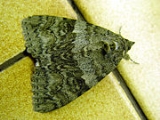
Red Underwing
Encyclopedia
The Red Underwing moth, Catocala nupta, is a moth
of Noctuidae family.
This is a large (80 mm wingspan) nocturnal Europe
an species which, like most noctuids, is drably coloured to aid concealment during the day. It flies in August and September, and comes freely to both light and sugar.
This species and other Catocala moths have brightly coloured underwings, in this case orange, red, or pink. These are not visible at rest, being hidden by the dull forewings, but they help the moth avoid predators such as bird
s if it is disturbed during the day.
As the Red underwing moth takes off, the sudden flash of colour may confuse the attacker, and when it lands and immediately closes its wings it may seem to disappear as the colour is "switched off". It is also thought that the symmetrical patterned orange sections on the rear wings form the illusion of another smaller creature (butterfly), so the attacker will go for the colourful "small illusive" rear safe region on the main body of this Red underwing moth species.
The adult feeds on nectar, the caterpillar
s eat willow
and poplar
leaves.
Moth
A moth is an insect closely related to the butterfly, both being of the order Lepidoptera. Moths form the majority of this order; there are thought to be 150,000 to 250,000 different species of moth , with thousands of species yet to be described...
of Noctuidae family.
This is a large (80 mm wingspan) nocturnal Europe
Europe
Europe is, by convention, one of the world's seven continents. Comprising the westernmost peninsula of Eurasia, Europe is generally 'divided' from Asia to its east by the watershed divides of the Ural and Caucasus Mountains, the Ural River, the Caspian and Black Seas, and the waterways connecting...
an species which, like most noctuids, is drably coloured to aid concealment during the day. It flies in August and September, and comes freely to both light and sugar.
This species and other Catocala moths have brightly coloured underwings, in this case orange, red, or pink. These are not visible at rest, being hidden by the dull forewings, but they help the moth avoid predators such as bird
Bird
Birds are feathered, winged, bipedal, endothermic , egg-laying, vertebrate animals. Around 10,000 living species and 188 families makes them the most speciose class of tetrapod vertebrates. They inhabit ecosystems across the globe, from the Arctic to the Antarctic. Extant birds range in size from...
s if it is disturbed during the day.
As the Red underwing moth takes off, the sudden flash of colour may confuse the attacker, and when it lands and immediately closes its wings it may seem to disappear as the colour is "switched off". It is also thought that the symmetrical patterned orange sections on the rear wings form the illusion of another smaller creature (butterfly), so the attacker will go for the colourful "small illusive" rear safe region on the main body of this Red underwing moth species.
The adult feeds on nectar, the caterpillar
Caterpillar
Caterpillars are the larval form of members of the order Lepidoptera . They are mostly herbivorous in food habit, although some species are insectivorous. Caterpillars are voracious feeders and many of them are considered to be pests in agriculture...
s eat willow
Willow
Willows, sallows, and osiers form the genus Salix, around 400 species of deciduous trees and shrubs, found primarily on moist soils in cold and temperate regions of the Northern Hemisphere...
and poplar
Poplar
Populus is a genus of 25–35 species of deciduous flowering plants in the family Salicaceae, native to most of the Northern Hemisphere. English names variously applied to different species include poplar , aspen, and cottonwood....
leaves.

